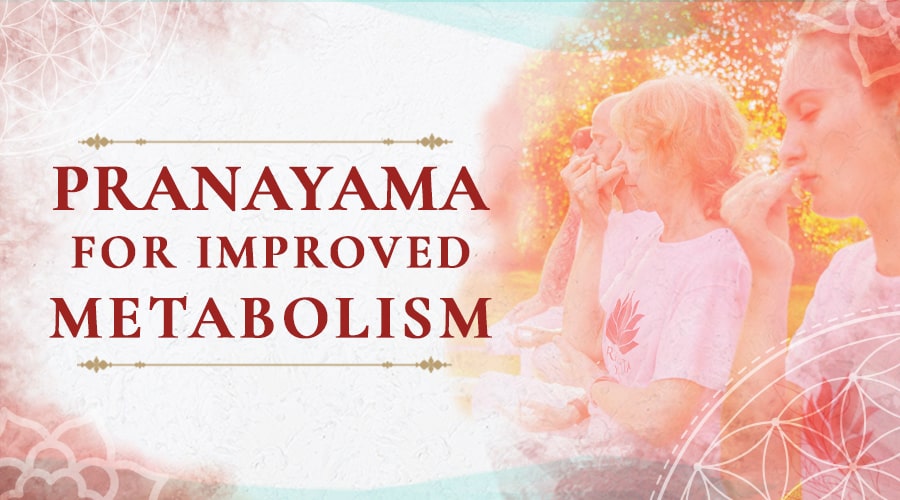Like yoga poses, pranayama is a form of ancient yogic breathing with remarkable benefits for the mind and body. These controlled breathing exercises target deep within, helping reduce stress, improve lung function, and even slow down aging. But, what if I told you pranayama can also improve a stubborn metabolism and increase weight loss?
Although pranayama was originally developed to boost the flow and storage of prana (life-force energy), new research is shining a light on how this practice can also speed up our metabolism, and, as a result, help you cut a few unwanted pounds. And, the findings are quite incredible.
If you're curious about how breathing exercises influence your metabolic rate and the best pranayama for metabolism increase, below I'll be exploring everything you need to know about boosting your metabolism and weight loss journey with just your breath.
What Is Metabolism & How Does It Work?
Metabolism is the chemical reactions in the body's cells that convert food into energy. Think of it like the engine of your body that uses fuel to keep everything running smoothly. This energy makes up the building blocks for your body and is used for everything you do, from reading this sentence right now, to walking, sleeping, and even breathing.
Can You Change Your Metabolism?
Metabolism has become a buzzword in the weight loss industry, with experts revealing the secret to shedding fat is a faster metabolism. It’s true that a speedy metabolism can help you burn calories quicker, but it’s important to remember that each person's metabolic rate is different. This is why it might be harder (or easier) for you to lose weight compared to others.
What many people don’t know is that there are several factors influencing your metabolic rate that are completely out of your control. These include:
- Age: As you get older, your metabolism tends to slow down. This is partly because you lose muscle mass and gain fat as you age, and muscle burns more calories than fat.
- Gender: Men usually have less body fat and more muscle than women of the same age and weight, which means men burn calories faster. As a result, men generally having a faster metabolism than women.
- Genetics: Your family’s genes can also influence your metabolism, from your basal metabolic rate (BMR)—the calories your body needs for basic functions—to where your body stores fat and your ability to build muscle. Hormonal imbalances like an underactive thyroid can also slow down metabolic functions.
Discover: How Yoga Can Help Thyroid Issues (Including 9 Effective Asanas)
All that said, there many factors that are in our control, such as:
- Physical Activity: Any movement needs energy. The more active you are, the more calories you burn, boosting your metabolism. This includes not just planned exercise such as yoga asana practice or running, but also the energy spent doing daily activities like walking up the stairs or washing the dishes.
- Diet: What you eat and drink can impact your metabolism, too. For example, your body uses more energy to process protein than it does fats or carbohydrates. One effective way to increase your metabolism is through a holistic diet of healthy proteins and fats with regular exercise.
- Stress: Chronic stress can lead to hormonal imbalances that affect metabolism. A common example is the stress hormone cortisol. Although not bad for you, producing too much cortisol over a long period can lead to several health problems, including weight gain.
- Sleep: Sleep is vital. If you’re not getting enough sleep, it can slow down your metabolism and change the way your body processes sugar, increasing your risk of obesity and diabetes.
Also read: Gentle Bedtime Yoga – 5 Yoga Poses for Better Sleep
How Does Pranayama Increase Metabolism?
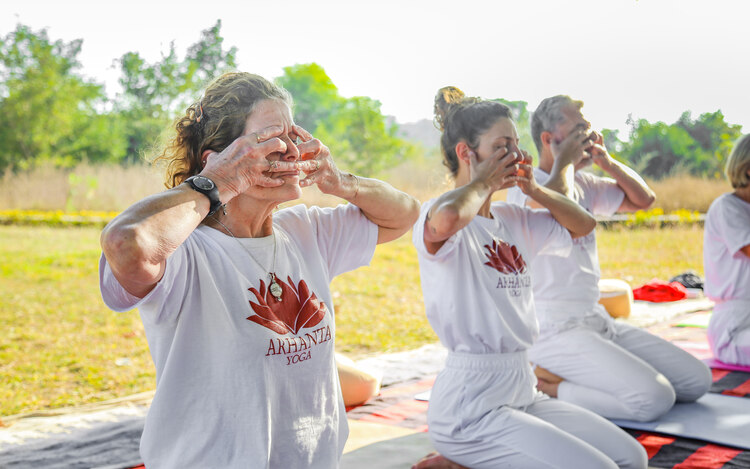
Pranayama is a form of breathing technique in yoga that purifies energy channels (nadis) and boosts levels of prana—energy needed for life-sustaining activities like blood circulation or breathing.
Different from breathing exercises, pranayama uses breath retention with bandhas (energy locks) to increase oxygen and the flow of prana in the body. This boosts energy levels and improves the functioning of vital bodily systems, which as a result can balance your endocrine system, boost your metabolism, and in the long-term, support weight loss.
For example, when you practice active pranayama exercises like Kapalabhati and Bhastrika, you're engaging in a kind of internal workout. These techniques use sharp, energetic breaths that work the abdominal muscles and significantly boost your oxygen intake. This process does two main things: it kicks your metabolism into a higher gear, which helps with better digestion and nutrient absorption, and it helps clear out toxins. This metabolic boost also means your body can burn calories more efficiently.
Let’s see other ways pranayama breathing increases metabolism and supports healthy weight loss.
Stimulates Digestion
Pranayama breathing techniques deliver more oxygen and stimulate your digestive fire, a concept from Ayurveda known as Agni, which is crucial for breaking down food and turning it into energy. Certain exercises, like Kapalabhati, also function like an internal massage for your stomach, helping things move along smoothly and preventing constipation.
Lastly, pranayama helps balance the nervous system and reduces stress, which is often linked to digestive problems like irritable bowel syndrome (IBS).
See: How Yoga Can Improve Digestion
Increases Resting Metabolic Rate
Research suggests that warming pranayama exercises like Bhastrika and diaphragm breathing exercises could boost our resting metabolic rate (RMR)—that's the rate at which we burn calories when we're completely at rest.
These exercises stimulate specific receptors in the body which trigger a chain reaction, activating the hypothalamus, pineal gland, autonomic nervous system, and various brain structures. As a result, there's a coordinated boost in activity across all body regions, positively affecting our endocrine (hormonal) and metabolic functions.
Reduces Cravings
Research on a modified Qigong breathing exercise was also shown to reduce or stop hunger sensations for one to several hours. In an experiment with 15 participants, this breathing exercise successfully lowered stomach acid and decreased intestinal pressure, which helped reduce feelings of hunger and control the appetite.
On a mental and emotional level, the rhythmic nature of pranayama breathing like Ujjayi Pranayama can turn our attention away from stressors and encourage us to find calm within instead of seeking comfort in food. This technique also promotes a mindful approach to eating, making us more conscious of the foods we eat and why.
Decreases Stress & Appetite Hormones
We’ve looked at how intensive pranayama techniques improve metabolism, but gentle techniques are equally as beneficial. Slow, deep breathing relaxes the body by sending out calming triggers that activate the parasympathetic nervous system (the body's rest and digestion response). These triggers include:
- Low muscle tone
- Slow, abdominal breathing
- Relaxed concentration
As our body shifts into the rest-and-regenerate mode, our heartbeat and blood pressure drop, digestive functions are stimulated, and the gas exchange in the lungs is improved. By activating the parasympathetic nervous system, we are also able to switch off the production of stress hormones like cortisol and other appetite-related hormones, which studies show can reduce food cravings and weight gain.
Try: 7 Powerful Yoga Practices for Burnout, Anxiety & Stress Relief
Best Pranayama for Metabolism & Weight Loss & How to Practice
Now that we’ve covered how breathing techniques can affect your metabolism, the next question is which ones should you practice to reap these benefits?
As with yoga poses, it will depend on your body and skill level. Some pranayama for weight loss and metabolism are vigorous and intensive, and others are more calming. It’s important to incorporate a balanced practice of both and find a combination that works for you.
Kapalbhati Pranayama (Skull Shining Breath)
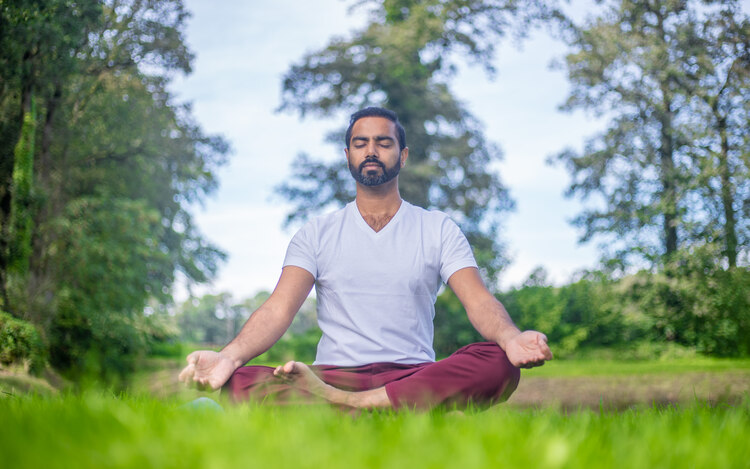
Kapalabhati, often called Skull Shining Breath, is a cleansing breathing exercise that's part of the six internal cleansing exercises known as Shat Kriyas. This technique involves some forceful exhalations, which not only gives your abdominal organs a good workout but also helps to release any stuck energy and toxins. As a result, it's great for increasing metabolism and helping your digestive system run smoothly.
Benefits:
- Strengthens the abdominal muscles
- Removes stale air from the bottom of the lungs
- Increases lung capacity and tones the lungs
- Improves digestion and function of the pancreas
- Stimulates sympathetic nervous system, which boosts metabolism
How to:
- Sit in a comfortable position.
- Bring both hands into Chin Mudra and place them on your knees.
- On count ‘1’, breathe out forcefully through both nostrils, pulling your belly towards the spine.
- On count ‘2’, relax your belly and let the inhalation happen naturally.
- Starting the first round, take an easy breath in, and 1, 2, 1, 2…. (30-50 pumping).
- Take an easy breath in and breathe out.
- Take a deep breath in and breathe out again.
- Take an easy breath in, hold for 20-40 seconds. Breathe out.
- Repeat for 3 rounds.
Bhastrika Pranayama
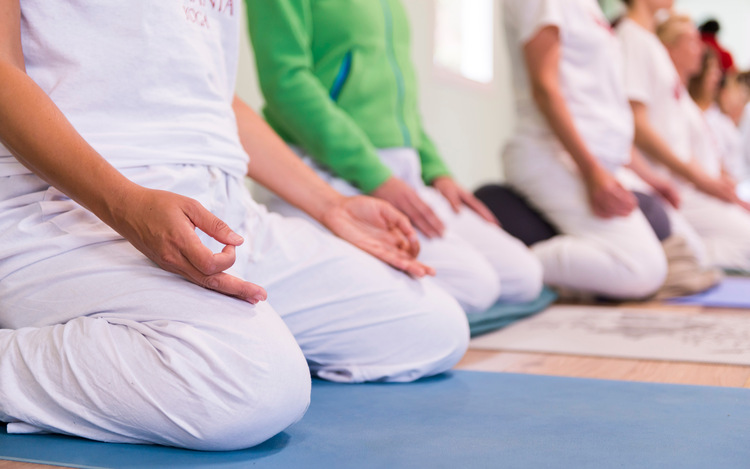
Bhastrika Pranayama is a more advanced version of Kapalbhati, with a focus on forceful inhalations and exhalations. Practicing Bhastrika Pranayama for metabolism is effective as it boosts your oxygen intake and activates the sympathetic nervous system, helping you burn more calories. The intensive breaths also activate the abdominal muscles for better overall digestion.
Benefits:
- Tones abdominal muscles
- Improves digestion and function of the pancreas
- Stimulates sympathetic nervous system, which boosts metabolism
How to:
We practice Bhastrika in three stages, using Bandhas for internal and external retention. There are two types of energy locks in Bhastrika Pranayama:
- Internal locks: Mula Bandha (root lock) and Jalandhara Bandha (chin lock) together on internal retention.
- External locks: Maha Bandha on external retention.
Stage 1: Only Internal Locks
- Sit in a comfortable position.
- Bring both hands into Chin Mudra and place them on your knees.
- Take an easy breath in, and 1, 2, 1, 2…. (30-50 pumping).
- Take an easy breath in and hold the breath. Apply internal locks (root and chin lock) for 2, 3, 4… (8-16 counts).
- Gently release the locks and breathe out.
- This completes one round. Continue for three rounds.
Stage 2: Only External Locks
- Sit in a comfortable position.
- Bring both hands into Chin Mudra and place them on your knees.
- Take an easy breath in, and 1, 2, 1, 2…. (30-50 pumping).
- Take an easy breath in and breathe out.
- Hold your breath and apply external locks (Maha Bandha) for 2, 3, 4… (8-16 counts).
- Gently release the locks and breathe in.
- Repeat for three rounds.
Stage 3: Internal & External Locks
- Sit in a comfortable position.
- Bring both hands into Chin Mudra and place them on your knees.
- Take an easy breath in, and 1, 2, 1, 2…. (30-50 pumping).
- Take an easy breath in and release the breath out.
- Easy breath in, apply internal locks.
- Hold the breath for 2, 3…. (8-16 counts).
- Breath out completely.
- Hold the breath and apply external locks for 3, 4… (8-16 counts).
- Gently release the locks and breathe in.
- Continue for three more rounds.
Ujjayi Pranayama (Ocean Breath)
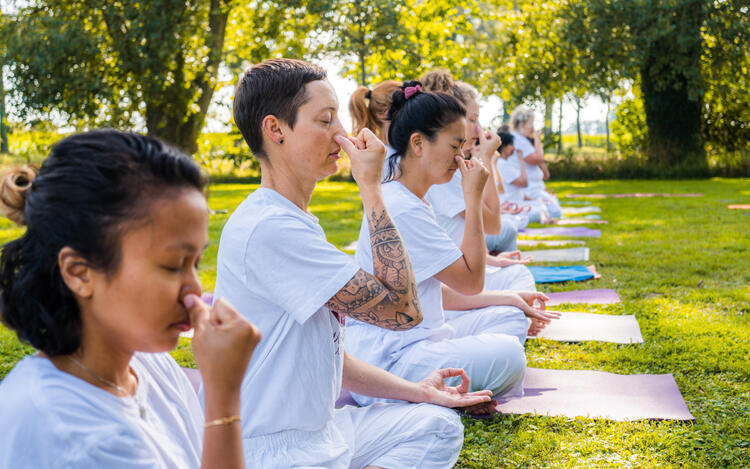
Ujjayi means “victorious” or “vibration”. In modern yoga, it is often referred to as Ocean Breath because of the gentle, ocean-like sound it creates as air moves in and out of the throat. As this technique encourages deep breathing, it decreases stress which can reduce the risk of excessive weight gain and unhealthy eating habits.
Benefits:
- Increases the solar/fire energy in the body
- Enhances concentration and relieves mental fatigue
- Decreases stress hormone levels which can help improve metabolism
How to:
Stage 1: Internal Locks
- Sit in a comfortable position.
- Bring your right hand into Vishnu Mudra and place it on your right knee.
- Bring your left hand into Chin Mudra and rest it on your left knee.
- Inhale for 1, 2, 3, 4 counts, making a snoring sound.
- Close your nostrils with your right hand.
- Apply internal locks and hold for 2, 3, 4…. (8-16 counts).
- Exhale left for 2, 3, 4…8.
- This completes one round. Continue for 8-10 rounds and maintain the timing of the counts—do not rush.
Stage 2: External Locks
- Sit in a comfortable position.
- Bring your right hand into Vishnu Mudra and place it on your right knee.
- Bring your left hand into Chin Mudra and rest it on your left knee.
- Inhale for 1, 2, 3, 4 (in a snoring manner).
- Close your nostrils with your right hand.
- Hold for 2, 3, 4…. (8-16 counts).
- Exhale left for 2, 3, 4…8.
- Apply external locks, and hold for 2, 3, 4… (8-16 counts).
- Continue for 8-10 rounds.
Stage 3: Internal & External Locks
- Sit in a comfortable position.
- Bring your right hand into Vishnu Mudra and place it on your right knee.
- Bring your left hand into Chin Mudra and rest it on your left knee.
- Inhale for 1, 2, 3, 4 (in a snoring manner).
- Close your nostrils with your right hand.
- Apply internal locks and hold for 2, 3, 4…. (8-16 counts).
- Exhale left for 2, 3, 4…8.
- Apply external locks, and hold for 2, 3, 4… (8-16 counts).
- Continue for 8-10 rounds
Final Thought
Yoga teaches us that everything is connected, and to fix one problem, we need to start at the very beginning: with the breath. When you make pranayama a regular part of your life, you awaken the connection between your body and mind, tapping into a world of healing. But remember, the purpose of pranayama is not to shed pounds or build the perfect body—although this is a bonus. Rather, it's a path to feeling more grounded, relaxed, and balanced in our daily lives. By practicing pranayama for metabolism, we can improve digestion, relieve stress, lose weight, and lead a healthier, longer life.

